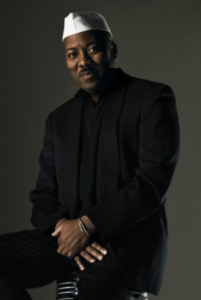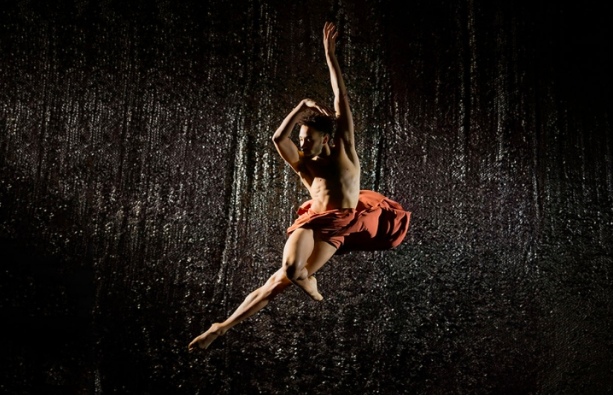Alonzo King is considered a dance treasure of the United States. His work with his company LINES in the community in his hometown of San Francisco and on the stages of the world is highly respected. Before his company comes to the National Arts Centre to present the work Sutra, in which the company collaborates with classical Indian instrumentalists, Zakir Hussain, a Grammy winning tabla player, and vocalist Sabir Khan, King answered some questions from ARTSFILE about dance and the meaning of art.
Q. Where does the LINES come from?
A. The term LINES alludes to all that is visible in the phenomenal world. There is nothing that is made or formed without line. Straight line and circle encompass all that we see. Whatever can be seen is formed by line. In mathematics, it is a straight or curved continuous extent of length without breadth. Lines are in our fingerprints, the shapes of our bodies, constellations, geometry. It implies genealogical connection, progeny and spoken word. It marks the starting point and the finish. It addresses direction, communication and design: a line of thought; a boundary or eternity; a melodic line; the equator. From vibration or dot to dot it is the visible organization of what we see.

Alonzo King
Q. What will audiences see with your production Sutra?
A. What someone sees is uniquely personal and completely dependent on their ability to see. What we see with is our consciousness. Consciousness is the lens that filters whatever is in front of us. That lens is usually conditioned by society, education, customs and whatever particular trend regarding right and wrong, superior and inferior, exists in a social construct. The Talmud states, “We don’t see things as they are, we see things as we are.”
What (we see on stage) I think will be obvious. It is a group of artists of exceptional quality generously giving to the best of their ability and pushing the art form. There will be the masterful manipulation of time and space with music and movement.
Q. What interests you about exploring culture?
A. I am interested in the uniqueness of the individual and the commonality of the human experience. Art is the great communicator. It is thought or consciousness made visible, or audible. The writings, dances and music of the ancients have certainly been a way for us to understand ourselves. Every culture has a unique gift to the world, and ideally it would be great to take the best of every culture. Yet within all cultures lies the uniqueness of the individual. So that even within a family of relatives it can seem that you are existing within numerous cultures of personalized views and experience.
Q. What matters to a dancer?
A. The most important thing to a dancer is how to communicate an idea clearly, whatever it takes. We sometimes forget that the idea comes first, and techniques are employed to bring the idea to life. Whatever is done requires technique. There is nothing that doesn’t use technique. How we use eating utensils whether fingers, chopsticks or forks are with techniques. There are also techniques that facilitate the heart’s expansion. The piano doesn’t play itself, the home doesn’t build itself. Technique and will power are inextricably linked. The archer has the the bull’s eye as his aim, and his sole concern is accuracy. Accuracy becomes your expression.
Artists are concerned with the communication of ideas, and that those ideas be accurate and clearly expressed. There are still some circles of thought which seem to think that artists are involved in indulgent self expression. This is not the case. Most artists are looking for the definitive choice, where the viewer upon seeing it will realize, there could have been no other choice, this is it. Self expression is dangerously close to likes and dislikes and emotional excretions. What you want to do and what you should do can be miles apart. It is a wonderful thing to see them integrated, where there is no conflict.
Q. What is dance’s place in the arts?
A. All the arts have proceeded from music and dance. Homer’s Iliad and Odyssey are certainly music. Dante’s Inferno is certainly dance. The elements of sound and movement, rhythm, rise and fall, crescendo are in all things. The brain moving, the heart beating, the pen writing, it’s all sound and movement. You cannot move without making sound, and you cannot make sound without some movement. Human eyes and ears are generally not as keen as those of the animals. Sound and movement are in all things. Even the seemingly still rocks. Science now tells us that everything that exists is a manipulation of light vibrating at different rates.
There is this idea about what some call pure dance. The truth can certainly be told while someone is moving and singing. The
absence of artifice is the only determination of what is pure gold unalloyed. There is nothing that happens alone. If one means by pure dance, dance without accompaniment, this does not exist. We are all accompanied by thought, the rushing blood, heart beat and breath, the light in any particular space, ambient and natural sound.
Q. What is the importance, or the power of art?
A. The artistic view can bring insight because the artist is interested in the essence of things, not their appearance. Many are the failed portraits that got the features but didn’t capture the person. As artists our obsession like scientists looking for the ‘X’ factor is to crumble the veils of delusion — to make the invisible apparent, to dive beyond appearance. Ideally each line of business should be an art for dispelling human miseries. To that end we have to reveal the gargantuan commonality that outweighs difference, to reveal the spirit that animates these borrowed temporary forms. (To that end we have to) aid in the knowledge that war doesn’t solve problems, race hatred and religious sectarianism are the deepest ignorance and materialism doesn’t bring happiness.
Traditionally art has been a way of life and key into that inner knowledge which has always existed, which always will exist and to which we all have access. This affects both patron and artist, which we all are. Access to that knowledge comes from a contemplative mind that takes periodic dives of focused introspections and regular breaks from the whirl of life’s daily carnival.
Alonzo King LINES Ballet presents Sutra
Where: Southam Hall
When: Nov. 16 and 17 at 8 p.m.
Tickets and information: nac-cna.ca







